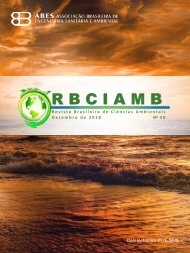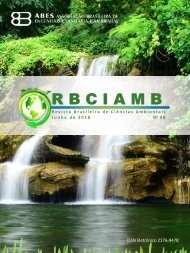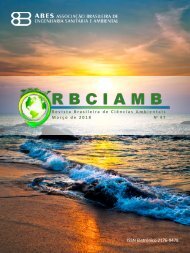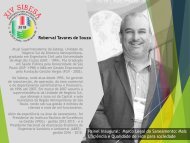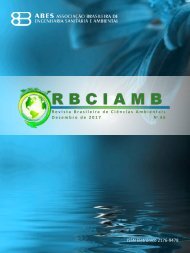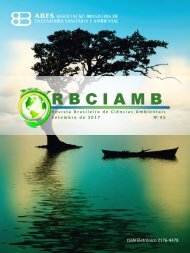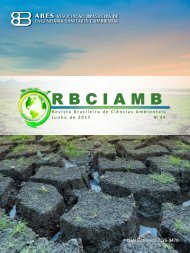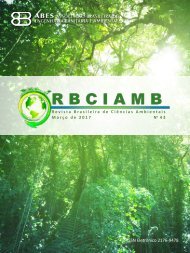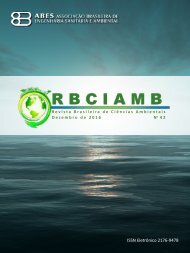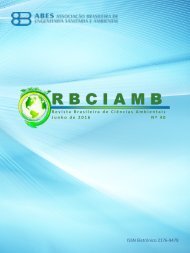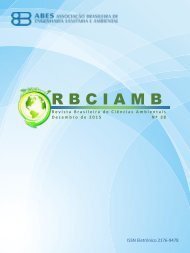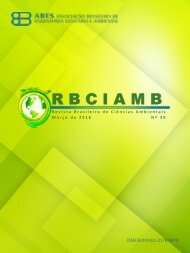EDIÇÃO 22 - Dezembro/11 - RBCIAMB
A Revista Brasileira de Ciências Ambientais – RBCIAMB - publica artigos completos de trabalhos científicos originais ou trabalhos de revisão com relevância para a área de Ciências Ambientais. A RBCIAMB prioriza artigos com perspectiva interdisciplinar. O foco central da revista é a discussão de problemáticas que se inscrevam na relação sociedade e natureza em sentido amplo, envolvendo aspectos ambientais em processos de desenvolvimento, tecnologias e conservação. A submissão dos trabalhos é de fluxo contínuo.
A Revista Brasileira de Ciências Ambientais – RBCIAMB - publica artigos completos de trabalhos científicos originais ou trabalhos de revisão com relevância para a área de Ciências Ambientais. A RBCIAMB prioriza artigos com perspectiva interdisciplinar. O foco central da revista é a discussão de problemáticas que se inscrevam na relação sociedade e natureza em sentido amplo, envolvendo aspectos ambientais em processos de desenvolvimento, tecnologias e conservação. A submissão dos trabalhos é de fluxo contínuo.
Create successful ePaper yourself
Turn your PDF publications into a flip-book with our unique Google optimized e-Paper software.
61INTRODUCTION Despite considered one of the hotspots of biodiversity on the Earth (Myers et al. 2000), the Savanna environment in Brazil, locally known as Cerrado, has become in the recent years a very attractive region for the development of biofuels, among which the production of ethanol from sugarcane (FERREIRA et al. 2007; ALMEIDA, 2003). The good efficiency of ethanol from sugarcane face other biofuels and fossil fuels, such as gasoline and diesel, provides a positive reflection for the Brazilian sugarcane industry, among which the significant expansion of sugarcane plantations in this biome (MENDONÇA, 2010; GIBBS et al. 2008). However, the common practice of burnings in the sugarcane pre-‐harvest phase threatens the environmental sustainability of this cultivation due essentially to the emission of greenhouse gases. The agricultural frontier for ethanol activity in Brazil has been now concentrated in the Midwest region of the country, more specifically in the savanna environment (locally known as Cerrado), already heading other important biomes like Pantanal and Amazonia, and making this activity essential to the economic and environmental monitoring (ALVES AND WANDER, 2010; RIBEIRO et al. 2009). In the specific case of Goiás, a state located in the core area of the Cerrado (central area in Brazil), the production of sugarcane ethanol is intensified since 2000, becoming coexistent with the already established production of grains (soybeans), cotton, rice and livestock (dairy and cut) (CASTRO et al. 2010), and an attractive region for the production of this renewable fuel (ALVES AND WANDER, 2010). However the disorganized growth of sugarcane cultivation in Goiás, based on the expansion of cultivated area rather than on the increase of productivity gains (CASTRO et al. 2010), is mentioned as a serious environmental problem, especially for the occupation of areas of native vegetation (forests and savannas) and for the use of burning in the pre-‐harvest phase of this cultivation (OMETTO et al. 2005; BORJA, 2007). Thus it is emitted a large amount of greenhouse gases (direct and indirectly) to the atmosphere, causing several social and environmental damage. Concerned about the levels of atmospheric concentration of greenhouse gases (GHG) resulting from this agricultural practice, in 1998 the Brazilian government met the requirements of the United Nations Framework Convention on Climate Change, by determining the gradual reduction of burning use at the mechanized areas by 2020 (in some regions, this period was reduced to 2014). Within this analytical perspective, this article aims at estimating the GHG emissions at sugarcane plantation areas in Goiás from 2005 to 2009. In order to meet this result the possibility of the use of two different and substitutes technologies will be considered: with and without the use of burnings. Following that the sugarcane expansion areas fields with burning scars will be identified by means of geo-‐referencing, providing actual data for the recalculation of GHG emissions. METHODOLOGY Study area This research is restricted to the State of Goiás, central area of Cerrado biome, due to its natural features, agricultural development (the second largest producer of ethanol in Brazil since 2009) and government incentives, factors that helped the establishment and expansion of sugarcane cultivation in the region (Fig. 1). Fig. 1 -‐ Study area, with the limits of the Brazil, Cerrado biome and the State of Goiás. Revista Brasileira de Ciências Ambientais – Número <strong>22</strong> – dezembro de 20<strong>11</strong> 61 ISSN Impresso 1808-‐4524 / ISSN Eletrônico: 2176-‐9478





